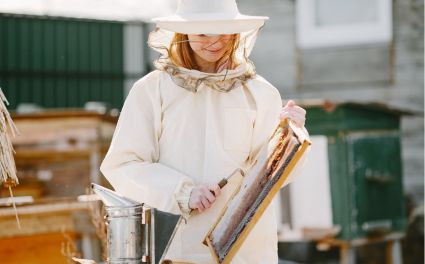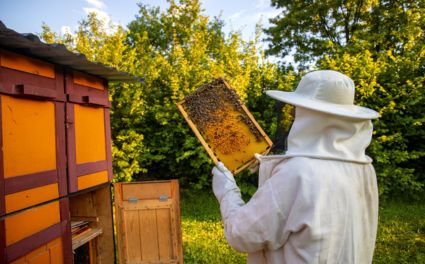If you’ve been around bees for a while, you’ve probably heard the old hands talk about splitting hives like it’s just part of the season. The truth is, once you get the hang of it, it is just another day’s work. But if you’re newer to the game—or even a seasoned beekeeper looking to grow your outfit—learning how to split a beehive the right way can set you up for a whole lot more success down the line.
Today, we’re gonna sit down and go through why splitting bee colonies is a game-changer, how to do it without a fuss, and why having a good beehive splitting guide can mean more bees, more honey, and a whole lot fewer headaches.
Let’s saddle up and get into it, beekeeper to beekeeper.
Why Bother Splitting Your Hive? It’s About A Lot More Than Just Growing Your Numbers
The first question folks usually ask is: Why should I split my hive at all?
Simple answer:
Because if you don’t, your bees sure as heck will.
Bees are built for survival and reproduction. When a hive gets too packed, they don’t hang around waiting for you to notice—they’ll up and swarm, with half your bees (and your queen) hightailing it to find a new home. If you’ve ever lost a hive to a swarm, you know it feels like someone kicked over your honey pot.
By splitting hives to keep swarming in check, you’re staying one step ahead. You get to:
-
Hold onto your bees.
-
Start a new hive packed with a strong workforce.
-
Boost your honey harvest when the season’s in full swing.
And honestly? Splitting is one of the best parts of smart beekeeping hive management. You’re not just keeping bees anymore, you’re building an empire.

When’s The Best Time To Split Hives? Timing’s Everything, Partner
The sweet spot for splitting is early to mid-spring when your hive’s starting to boom with bees but before it gets too crowded. Depending on where you’re at, that could be anytime from late March through May.
Look out for these signs:
-
Frames packed with capped brood
-
Plenty of honey and pollen stores
-
Queen cells are starting to pop up
Gearing Up: Tools That Make A Beekeeper’s Life Easier
Before you go diving into hive boxes, make sure you’ve got your gear in order. Nothing ruins a good split faster than getting stung up because you weren’t ready.
Start with a reliable Ventilated Beekeeping Suit or even a breathable 3-Layer Khaki Beekeeping Suit. For younger helpers, our Beekeeping Kids Suits keep the little ones safe.
Don’t forget:
-
Beekeeping Gloves for sting protection
-
Beekeeping Veils if you prefer a lighter setup
-
Beekeeping Jackets for flexibility on warmer days
-
Beekeeping Trousers and Ankle Protection for full coverage
Use the OZ Armour smoker to keep your hive calm and make inspections smooth.
You’ll also find everything you need in our full Beekeeping Equipments and Beekeeping Kit with Suit collections.
How To Split A Beehive Without A Hitch: Step-by-Step
🔹 1. Give The Hive A Good Look
Pick a strong, bustling hive with:
-
8–10 frames full of bees
-
Brood at all stages
-
Enough food stores
🔹 2. Find The Queen
Locate her if you can. If not, don’t panic—your bees can raise a new one.
🔹 3. Set Up The New Hive
Get your second hive setup ready. The Ready-to-Assemble Full Depth Hive Box from OZ Armour makes life easier.
Place it a few feet away from the original.
🔹 4. Move The Frames
Transfer 3–5 frames including:
-
1–2 with capped brood
-
1 with honey and pollen
-
1 empty/drawn comb
Bring a good number of bees with the frames too.
🔹 5. Queen Management
You can choose to move the queen or let the split raise a new one—depends on your strategy.
🔹 6. Support The Split
Feed both colonies sugar syrup if resources are low and monitor their progress every few days.
Splitting Hives: A Solid Investment In Your Beekeeping Future
Each successful split is an investment in more productivity, stability, and resilience. By next season, your Pink Beekeeping Suit might be all over the bee yard as you grow your team!
Raising local bees also means you’re building colonies that are well-adapted to your climate—far better than imported packages.
Rookie Mistakes To Dodge When Splitting Hives
-
Splitting a weak hive
-
Leaving both colonies queenless
-
Forgetting to feed the new hive
-
Neglecting to monitor progress

One Last Thing: There’s More Than One Way To Split A Hive
Some do walk-away splits, others introduce a new queen. You could even split pre-nectar flow to maximize honey production.
Whether you're after:
-
A bigger bee yard
-
Swarm prevention
-
More honey on tap
…your technique should match your goal.
Why Splitting Hives Feels Darn Good
Splitting bee colonies isn’t just management—it’s empowerment.
With the right gear, like the trusted Beekeeping Suits, smokers, tools, and protective wear from OZ Armour, you’re not just keeping bees—you’re growing a legacy.
More bees. More honey. More good days in the bee yard.












